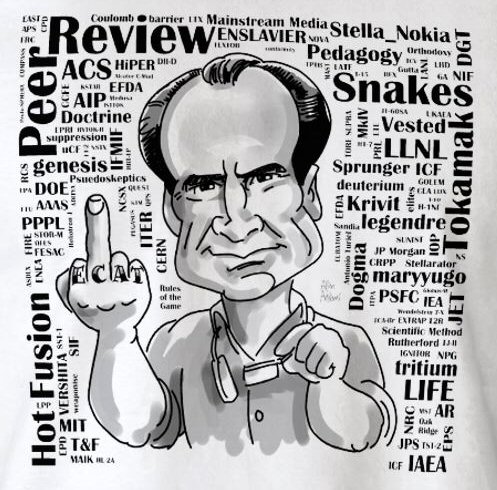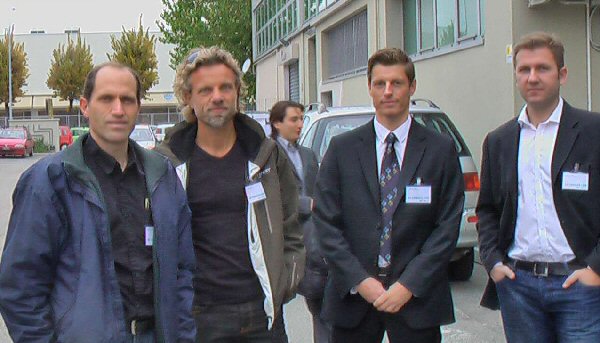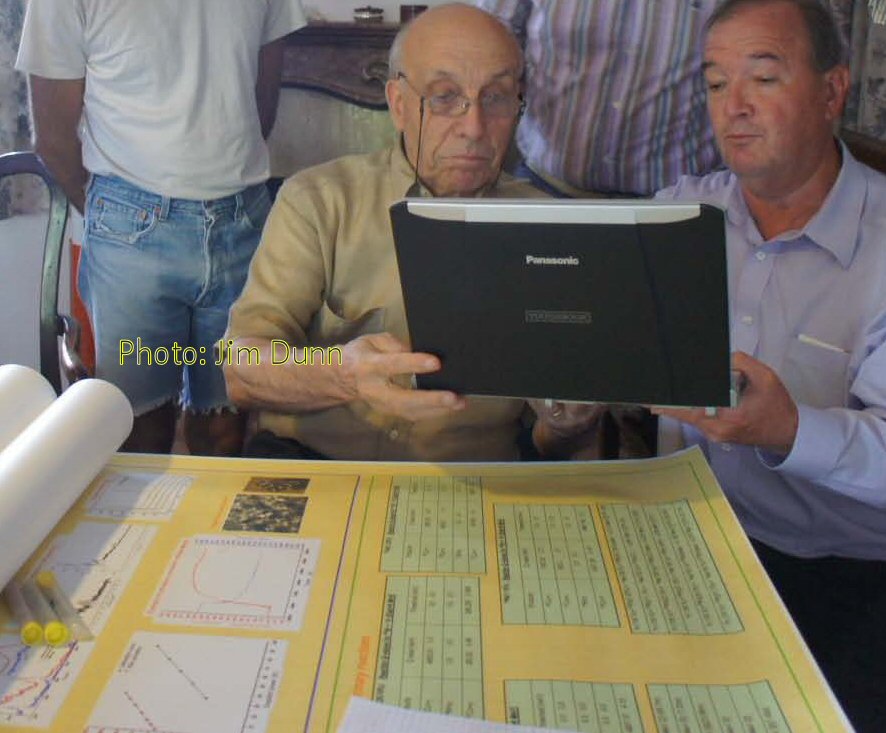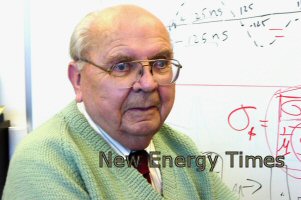A Six-Year Retrospective of Steven B. Krivit’s Rossi E-Cat Fraud Investigation
By Steven B. Krivit
Originally Published Nov. 2, 2016
Updated Oct. 28, 2022
On July 30, 2011, Editor Steven B. Krivit, of New Energy Times, published “Report #3,” a 200-page technical analysis of Andrea Rossi’s claimed energy device, which he named the Energy Catalyzer, or E-Cat. Dozens of scientists and engineers from around the world contributed their analyses to Krivit’s report. They were able to debunk Rossi’s claims from by watching what Krivit filmed on June 14, 2011, in Bologna, Italy.
In another article, “Forty-Eight Hours in Bologna: The Failure of Rossi’s Energy Catalyzer, Caught on Video,” Krivit describes his visit to Bologna.
Back to Rossi Investigation Summary
Petroldragon
Andrea Rossi is a convicted white-collar criminal with a string of failed, probably fraudulent energy ventures.
His first energy project took place between 1970 and 1990, when he convinced people that he could turn industrial waste into fuel. Rossi’s company produced no fuel. Instead, it created toxic waste and environmental damage, leaching chemicals such as dioxin into the land and groundwater in the Milan, Italy, area.
Rossi assured credulous supporters of his E-Cat project that he had been acquitted of all crimes (despite serving time in prison twice) and that his environmental disaster was the fault of a government conspiracy with the oil industry. More than 100 Italian newspaper articles have published the facts of Rossi’s Italian financial and environmental criminal history. New Energy Times has researched and compiled a list of those articles.
Luigi Acerbi, the mayor of Lacchiarelli, Milan, Italy, after seeing Rossi’s waste-to-oil catastrophe, told Italian journalists on RAI-TV that he was mystified by Rossi’s exceptional ability to create illusions:
In the years when he was working here, Rossi didn’t produce a single drop of oil, as far as we know. What he did was just create a media event. He was able to persuade — in a way that I cannot explain — a good portion of public opinion, and that’s exactly what is hard for me to explain. He persuaded technicians in the field, scientists, and important institutions in the region of Lombardia that he was able to do magic.

1980s: A pile of used tires and waste in front of Rossi’s Petroldragon machine. Image courtesy L’Unita
Thermoelectric Devices — U.S. Army
In 2001, after Petroldragon, Rossi convinced the U.S. Army that he could produce thermoelectric devices that would have record-breaking efficiency. According to the Army report, not one of the devices Rossi had agreed to deliver under contract worked as claimed.
Specifically, the devices produced only 1 Watt of power. Rossi had claimed the devices would produce 800 to 1,000 Watts each. Rossi told the Army that the failure was caused by poor workmanship by his subcontractor. The New Energy Times article “Rossi’s Profitable Career in Science” goes into this matter in greater detail.
Energy Catalyzer (E-Cat)
In 2011, Rossi began promoting a device he called the Energy Catalyzer, or E-Cat. Taking one step at a time, he convinced a few credulous scientists that he had developed an energy technology, a tabletop low-energy nuclear reaction (LENR) device with a power gain they had only imagined.
On July 30, 2011, in our Report #3, New Energy Times was the first to expose how Rossi was falsifying the power claims on the first version of his device. He didn’t give up, nor did the members of his fan club. Rossi redesigned the device with new tricks that made accurate heat measurements very difficult, if not impossible. When those new tricks were found, he designed the next device. Rossi developed excuses to cover his past promises and made new promises to distract his fans and keep them believing and hopeful.
He regularly claimed to have had independent parties verify his devices, but he never allowed those parties to have full control of and access to his devices. In all cases, Rossi had a hand in what he and some of his promoters called “independent” tests of system thermal output.
Older LENR Scientists Welcome Rossi
Rossi found a warm welcome from several of the older scientists in the LENR field. A few weeks before their annual International Conference on Cold Fusion (ICCF-16) took place in February 2011, Rossi staged a press conference and demonstration of his first device.
One of the key LENR scientists with whom Rossi collaborated was Michael Melich (1940-2019). Melich was affiliated with the U.S. Naval Postgraduate School and the Naval Research Laboratory. Melich was also listed as a member of the board of advisers of Rossi’s Web site. Melich took to the podium at the ICCF-16 conference, implied that Rossi might be the equivalent of Nicola Tesla, and encouraged the LENR community to help Rossi.
Other longtime scientists involved in the LENR field who helped promote Rossi included Edmund Storms (b. 1931), Michael McKubre (b. 1948), David Nagel (b. 1938), Mitchell Swartz (b. ~ 1949), Mahadeva Srinivasan (1937-2020) and Nobel laureate Brian Josephson (b. 1940).
On Aug. 2, 2011, Edmund Storms, one of the most prolific Internet “cold fusion” promoters, wrote an e-mail to colleagues and enthusiasts anticipating the commercial viability of Rossi’s apparatus:
The entire field of cold fusion will grow rapidly and provide jobs for those of us who have slaved in the dark for so long. Personally, I hope [Rossi’s apparatus] works as claimed, and I will do everything I can to promote the idea and work to make it better. Kicking Rossi at this stage just because the claim is not fully proven seems counter-productive to everyone. We desperately need the Rossi claim to be real.
When McKubre, Nagel, and two other LENR scientists, Peter Hagelstein and George Miley, were interviewed in the fall of 2011 for a case study of emerging scientific fields for the U.S. Intelligence Advanced Research Projects Activity, they told the government that Rossi’s device was a real, working, commercial LENR energy device, according to documents I received, under the Freedom of Information Act, from the Office of the Director of National Intelligence.
Only one LENR researcher, Francesco Celani, sounded alarm bells. At ICCF-16, Celani reported his experience observing Rossi’s demonstration. He also explained that Rossi’s protocol to measure the energy gain was a “conceptual mistake.” Celani’s concerns were drowned out by the celebratory mood created by the more prominent leaders in the LENR field.
The very first LENR researcher with whom Rossi collaborated was the frail, elderly Sergio Focardi, a professor emeritus from the University of Bologna Department of Physics. Based on my experience interviewing Focardi in person, Rossi had ingratiated himself with Focardi, who had no idea how Rossi had used the elder’s reputation and imprimatur to establish the appearance of credibility in the LENR field.
Mats Lewan Assists Rossi
Another key Rossi collaborator was technology journalist Mats Lewan, writing at the time for the Swedish technology weekly Ny Teknik. Lewan took what Rossi told him on faith, and, as professional journalists would never do, helped Rossi with his experiments, I learned later.
Lewan collected data for Rossi three times, wrote technical reports based on the data Lewan had collected, then wrote news stories based on his own technical reports. It was a mindboggling breach of journalistic ethics.
Beyond that breach, Lewan ignored multiple warning signs about Rossi’s grossly exaggerated power claims. The signs were obvious to many people who read Lewan’s articles and watched Lewan’s videos of Rossi. Regardless, Lewan kept feeding false hopes to his readers, ignoring Rossi’s many factual inconsistencies, and overlooking the ever-changing string of unfulfilled promises Rossi made to his fans.
Lewan had visited Rossi before I did. In the beginning, when I assumed that Lewan was doing a professional job as a journalist, he gave me some (false) hope too. Thanks to Lewan, I allowed that there might have been some validity to Rossi’s claims.
Lewan also contacted two Swedish scientists, Hanno Essén and Sven Kullander, who publicly endorsed Rossi’s claim. But, as I later learned, they had done so sight unseen, based on Lewan’s news reporting. Rossi then paid Essén and Kullander to come to Italy to look at his device.
Lewan reported that Essén and Kullander had conducted independent verifications of Rossi’s claim. I later learned that they had only gone to look at Rossi’s device and perform cursory checks. Lewan published a news story that Giuseppe Levi, a researcher with the University of Bologna Department of Physics, had performed an independent test on Rossi’s device.
Based on what I believed were accurate news stories by Lewan, I booked my flight to Italy. I have described what happened during my visit, and what I discovered there, in the companion article, “ Forty-Eight Hours in Bologna: The Failure of Rossi’s Energy Catalyzer, Caught on Video.” After technical experts reviewed my video footage, I was convinced that Rossi had committed science fraud.
Rossi’s Next Scheme
Rossi didn’t give up. Next, he changed his experimental design to produce hot water instead of steam. Roland Pettersson, another Swedish scientist, examined that version of Rossi’s device. He found that Rossi — supposedly an expert in the use of thermocouples — had placed them in the incorrect location in the experimental system, thus giving an inaccurate reading of the water temperature. When I discussed this with Pettersson, he was not willing to consider that Rossi’s placement of the thermocouples might have been intentional. But then Rossi got rid of the thermocouples and changed the experimental design to use radiant heat as the basis for thermal measurements.
Throughout 2011, Rossi sought credibility for his claim of extraordinary levels of excess heat through scientific and academic validation. In 13 attempts, he and his group tried to demonstrate convincing experimental evidence for their claims. In all attempts, he and his group failed. They never produced any experimental evidence on which to base their extraordinary-energy claim.
Internet Fan Club
As part of his scheme, Rossi developed an Internet fan club by appealing to their genuine hopes and dreams of a better world, powered by clean, cheap fusion energy. At my last count, Rossi had exchanged more than 28,500 messages on his blog with his fans.
By 2011, like a Pied Piper, Rossi had inspired his fans to create more than 80 Web sites to promote his E-Cat. Many of these sites appeared to be “ghost” sites, filled with content intentionally designed to manipulate Web statistics and search engines. Some of them appeared to be owned by the same people and promoted Rossi’s E-Cat devices as commercially capable thermal power sources. For a while, Rossi kept his fans in a perpetual state of expectation, assuring them that he had proven his E-Cat in the marketplace and that he had sold his “working reactor” to a purported customer. When evidence of each purported sale did not hold up, Rossi convinced his fans that he had a new customer.
Beyond the faith of these well-intentioned members of the lay public, he also fueled a more aggressive tribe of coordinated Internet supporters who expressed their discontent with big oil, peer review, conventional fusion research, and anyone like me who publicly challenged Rossi’s exaggerated claims. The image from a T-shirt designed by one of Rossi’s fans illustrates their sentiments about critics and the scientific establishment.

T-shirt designed by Rossi supporter Tony McDougall
Sterling Allan, Pedophile
Another major promoter and business associate of Rossi was Sterling Allan, of Fountain Green, Utah, the creator of Pure Energy News Service and the Free Energy Blog. Sterling’s darker side was revealed in February 2016, when he was arrested on multiple counts of child sex abuse, according to the Provo, Utah, Daily Herald. According to the Daily Herald, police reports say that a special agent with the FBI received a tip in January 2015 that Allan was involved in the sexual exploitation of children — his own. Allan is a divorced father of three girls and one boy. Allan admitted in a YouTube video that he had what he called a “predisposition to pedophilia.” In 2016, he was convicted and on his way to prison.

Rossi promoters Sterling Allan and Mats Lewan and two unidentified Swedish visitors at the building used by Rossi, Oct. 28, 2011.
Absurdity and Satire
After gaining widespread Internet exposure thanks to Lewan and Allan, Rossi was moderately effective in getting mainstream media attention from Fox News, Wired U.K., Forbes, and a few other news outlets. What the Rossi E-Cat story lacked in legitimate science, it made up for in entertainment value. A photo surfaced on the Internet showing his purported 1 MW thermal E-Cat reactor still sitting in his garage months after he told fans that he had already sold and delivered it to an unnamed customer. When asked about the contradiction, Rossi said that there had been a problem with gaskets. When asked why he had told people that his device had been delivered, he said that there had been a translation error when he had previously announced that the device had been sold and delivered.
The E-Cat phenomenon garnered a fair share of well-deserved satire on the Internet, but the widespread repercussions took their toll on the LENR field. In 2012, the commander of the U.S. Navy’s Space and Naval Warfare Systems Center in San Diego shut down LENR research at the base after Fox News published a false association of the SPAWAR researchers with Rossi. The entire affair left an odor that permeated the field for years.
Loss of Faith
Along the way, even some of Rossi’s most enthusiastic supporters, like Paul Burns (a.k.a. Paul Story), realized that Rossi regularly lied to them. Burns was the publisher of one popular Rossi fan site, ecatnews.com.
By 2012, Burns began to see the extent of the scam. “Even his supporters admit he lies as they excuse him for one reason or another,” Burns wrote. Burns warned his readers on Nov. 2, 2012, in a post title “The LieCat,” that Andrea Rossi was acting like a fraudster. (Burns PDF)
“The world needs a miracle more than anyone’s misplaced pride,” Burns wrote. “Until then, if you have given this man money, it is time to push him hard. Do not give him anything unless any promise he makes is accompanied by hard evidence. The first people to prod Madoff got their money back before it all collapsed. You have been warned.”
“Each time some deadline approaches,” Burns wrote, “Rossi changes tack, often making ever-increasing outlandish claims that have become tiringly predictable. The man is a liar, and if you give him money on the strength of his word, you are more trusting than me.”
The Rossi Faithful
After Burns shut down eCatNews, E-CatWorld.com remained the last major Internet watering hole for Rossi believers. The Web site is maintained by Frank Acland, a science fiction and fantasy writer. Acland has a Web page on which he denies that he has a business affiliation with Rossi and on that same page advertises where members of the public can pre-order Rossi E-Cat devices.
Acland’s faith in Rossi is based on his confidence in the judiciousness of two Italian scientists, Sergio Focardi and Giuseppe Levi, and two Swedish scientists, Sven Kullander and Hanno Essen.
“I don’t see any way that Rossi could have hoodwinked these professors with some kind of rigged machine,” Acland wrote.
Rossi’s first trick was simple: He dumped hot water coming out of his E-Cat device down a hole in the wall in the adjacent room but promised the credulous scientist-believers that his device was producing only steam. He assured the scientists that he had measured the output and performed all the checks and that they could trust him. So they did.
Acland also based his faith on the false belief that Rossi was not trying to defraud people.
“There has been no appeal for the public to send him money,” Acland wrote, “and no one has come forward and said that Rossi has tried to defraud them. … The Cherokee/Industrial Heat connection is an indication that serious professionals have done due diligence into Andrea Rossi’s work and have been convinced that the E-Cat is a technology worth investing in.”
Acland had reasoned that, because Rossi had appealed not to the public but to wealthy investors, Rossi’s claims were legitimate. Acland didn’t seem to know that, in 2011, Rossi had demanded that multiple parties, including NASA, pay him large sums of money for the privilege of taking a close look at his E-Cat device.
Psychopath or Sociopath?
Bob Tinvan, a faithful Rossi supporter, wrote on Acland’s Web site that he couldn’t imagine the unimaginable.
“It seems unrealistic that Rossi could be weaving such an enormous web of lies: He would have to be a brilliant psychopath to perpetuate the story for so many years.” – Bob Tinvan
That is precisely the analysis of potential investor Brian Scanlan, who met Rossi at a meeting arranged by Michael Melich and his wife, Marianne Macy. (Scanlan PDF) Melich and Macy were the first Rossi promoters in the LENR field. Scanlan eventually saw through the smoke:
Take a look at “How to Spot a Sociopath. Most of us in this group have trouble with the basic questions, “Why would Rossi try to pull such a brazen fraud? How did he expect to get away with it?” Answer — Some people crave control. For some, control is much more important than money. And Rossi has succeeded. He’s hijacked the LENR agenda, which has derailed countless sincere and promising research efforts. Folks, it’s time to move on.
Confidence Men and Cash
Another answer to why Rossi would pull such a brazen scam is that he had figured out how to make a profit from energy scams and mostly stay out of prison.
Rossi tried several times to make deals with investors, but each one walked away, as I explained in my book Hacking the Atom. Finally, Rossi gained the confidence of Thomas Darden, the founder and chief executive officer of the $2 billion private equity fund Cherokee Investment Partners. Darden, in turn, gained the confidence of 13 investors, formed a new company called Industrial Heat, and began promoting Rossi’s E-Cat. Darden and his investors agreed to purchase the dubious E-Cat system for $100 million. Darden, in turn, gained the confidence of Neil Woodford, to the tune of $50 million. (See Mark Shapland’s article and David Ricketts’ book.)
Darden had allowed Rossi to manage the first due diligence test, and Darden accepted Rossi’s personal assurance that the test worked as Rossi had claimed. I’m not making this up. In August 2013, Industrial Heat made the first payment to Rossi — $11.5 million.
A few days later, Rossi purchased $2 million worth of commercial real estate in Miami Beach, Florida. Two months later, Rossi had purchased another $1 million worth of property.
Darden made the next due diligence test — with an $89 million pot of gold at the finish line — harder. He didn’t let Rossi control it. The test was designed to run for a year.
According to court documents, that test concluded on Feb. 15. 2016. Rossi claimed it had been successful; Darden and associates disagreed.
On April 5, 2016, Rossi sued Industrial Heat for non-payment of $89 million and for attempting to steal his technology. Three days later, Industrial Heat issued a statement saying that the company “has worked for over three years to substantiate the results claimed by Mr. Rossi from the E-Cat technology — all without success.”
On April 10, 2016, Storms still defended Rossi: “Naturally, some exaggeration, fraud, and lying would be involved because people do not like to give money without knowing the secret, which cannot be revealed.”
Credible Scientific Origins
Rossi had poached valid scientific ideas from credible LENR research performed years earlier by another Italian scientist, Francesco Piantelli, a biophysicist. I went to see Piantelli in 2007 and in 2008 wrote about his research in two articles, “Deuterium and Palladium Not Required” and “Piantelli-Focardi Publication and Replication Path.”
For many years, Piantelli performed LENR research with his colleague Focardi. Both men had legitimate academic credentials and scientific backgrounds and a long history of credible LENR research, some of which they published in peer-reviewed journals.
Around the time I published my 2008 reports on the Piantelli group work, Rossi approached Piantelli and asked to work with him. Meanwhile, several American scientists began asking me to help them contact Piantelli. I had a bad feeling about their requests, so I declined to give them Piantelli’s contact information. Piantelli declined to work with Rossi. Instead, Rossi approached Focardi, who was old, in poor health, and eager for a second chance.
“I received a phone call from Rossi to speak together about a problem, and from the meeting that we had after the phone call, I understood that Rossi was bringing new ideas in the field and it was worthwhile to work together,” Focardi told me. “I understood that the problem of getting reactions had been resolved. Just from the first experiment that we made together, I understood the problems had been resolved.”
Focardi died two years later, in 2013.
Recognition of Piantelli’s discovery and his and Focardi’s work has inspired replication attempts of the nickel-hydrogen LENR system around the world. Piantelli never understood how to reliably produce the materials needed to achieve the spectacular results that he and his team observed. But someone sometime probably will.
Click here to read the companion article “Forty-Eight Hours in Bologna: The Failure of Rossi’s Energy Catalyzer, Caught on Video.”

Francesco Piantelli (left) Photo: Jim Dunn





